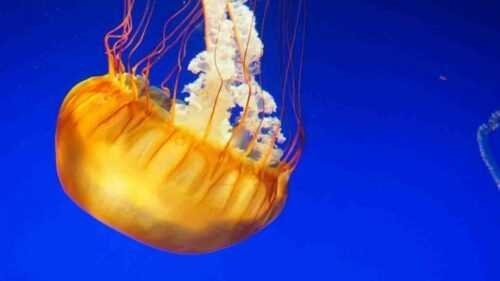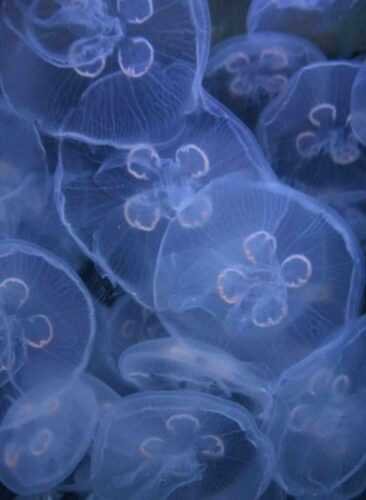
Have you ever heard of Palau in Indonesia? If not, then it’s for sure that you will put it on your bucket list. Palau is the most beautiful place in Indonesia because it holds a rare attraction that lures visitors every year. It is the Palau jellyfish lake.
For those wondering where the lake is in Palau- it is in the Eil Malk, Rock Islands, Palau.
This lake is home to millions of jellyfish. Two types of species live in this lake – Golden and Moon.

Jellyfish Lake Age
The jellyfish lake in Palau is believed to be around 12,000 years old, judging by the lake’s thickness and depth. It began filling up with water due to the rising sea level, which happened 12,000 years ago.
Lake Jellyfish Species
It is well-known for its special kinds of jellyfish that live there. When people visit, they get to see many different types of jellyfish that create an amazing and mesmerizing show.
Usually, two types of jellyfish are found there:
- Golden Jellyfish
- Moon Jellyfish
Golden Jellyfish
The golden jellyfish are closely related to the spotted jellyfish occupying nearby lakes. They are so similar that they obtain half of their food from symbiotic algae and half from zooplankton.
However, the golden jellyfish are different from the spotted jellyfish in many aspects, i.e. morphologically, behaviorally, and physiologically.
The golden jellyfish doesn’t have as many spots on their exumbrella as the spotted jellyfish, and the amount of clubs in its body has receded.

Michael Dawson, a marine biologist, suggested that the golden jellyfish living inside Palau Lake should be categorized as the subspecies of the spotted jellyfish inhibiting in the nearby lakes.
Moon Jellyfish
The scientific name for the moon jellyfish is known as Aurelia Aurita by Hammer.
Nevertheless, since the 1981 report on the genetic testing of Aurelia’s specimens, it indicated that besides the three named species of Aurelia, there are six other cryptic species in the Aurelia subdivision.
The three cryptic species that were discovered were from Palau.
Before you start thinking of scuba diving with these species in the lake, I’m afraid you might have to tell you to scrap that thought out of your mind.

Because scientists warn that the jellyfish population is in danger, and slowly these species are getting extinct. Also, the deeper anoxic surface of the lake contains hydrogen sulfide, which is extremely poisonous to humans.
Freshwater Jellyfish Lake
The freshwater jellyfish are as small as a penny, pellucid and slimy blobs occupying Pennsylvania’s lakes, streams, rivers, and ponds. In the freshwater lake, they do bite people.
However, their stingers are very tiny and don’t infiltrate human skin. The scientific name for the freshwater jellyfish is Craspedacusta Sowerby, and they are categorized as an invasive species. Other biologists like Sarah Stahlman put them in a non-native species department.
Irrespective of their classification, the Ontario Ministry of natural resources & Forestry reported last year that Lake Erie seems to have been invaded by the freshwater jellyfish in Lake Erie & Lake St. Claire.
Biologist Sarah Stahlman says freshwater jellyfish are fond of slow-moving and still waters. And these species are of two forms; Polyp forms & Hydromedusa forms.

She explained further about these two forms as the Polyp forms wouldn’t recognize by humans as they can be asleep in sediment for the longest of time. They seem to be more in the eastern zone of the US.
However, in Pennsylvania, they are all over the place. It depends upon the temperature. You’d see Hydromedusa more in the warmer temperature waters.
These jellyfish live at the bottom of the lake as polyps which consider an early stage in the species’ life cycle. Scientists are optimistic that if the lake’s situation improves, a new generation of the Hydromedusa will produce.
Most of the researchers and authorities deduced that the freshwater lake doesn’t raise any threat to humans. Few experts urged that the lake’s unique ecosystem’s future might be jeopardized due to climate change.
Regardless of these claims and significant news, I would recommend that one should go and explore this Lake Indonesia before they become extinct.
Keeping in mind that the tourists can no longer swim with the golden jellyfish, Kakaban Island came up with an alternative to Palau, where it offers its tourist to swim with four different species of jellyfish that have developed without any stingers.
Stingless Jellyfish Lake
It is a popular attraction on Eil Malk Island in Palau. It is known for its unique ecosystem, home to millions of stingless jellyfish. The lake is a popular spot for snorkeling and diving, as visitors can swim alongside the jellyfish without the risk of getting stung.
Many visitors praise the lake for its clear and calm waters, providing a great underwater photography opportunity. They also appreciate the chance to get up close and personal with the jellyfish, which are known for their pulsing and graceful movements.
Jellyfish Lake Facts
It is a unique natural wonder located on Eil Malk Island in Palau. Here are some interesting facts about the lake:
- It is home to millions of jellyfish, but they are a special type of jellyfish known as golden jellyfish or mastigias.
- Over time, these jellyfish have lost their ability to sting, so it is safe for humans to swim with them.
- The lake has a depth of about 30 meters and covers an area of around 0.6 hectares.
- How was Jellyfish Lake formed? The jellyfish population in the lake is believed to have originated from a few jellyfish trapped in the lake when it separated from the ocean around 12,000 years ago.
- The jellyfish in the lake migrate across the lake daily in search of sunlight, which they need for their photosynthesis process. This movement is known as diurnal migration.
- It is part of the Rock Islands Southern Lagoon, which was declared a UNESCO World Heritage Site in 2012.
- The lake was closed to tourists from 2017 to 2019 due to a decline in the jellyfish population, but it has since reopened with limited numbers of visitors allowed.
- Swimming with the jellyfish in the lake is considered to be a once-in-a-lifetime experience, and it has become a popular tourist attraction in Palau.
Best Time to Visit Jellyfish Lake
The recommended time to visit the lake is between November and April when there is less rain.
This is when the weather is more stable, there is less rain, and the water is calmer. These good conditions let you have a great time, including swimming with the jellyfish.
But remember, the number of jellyfish can change at different times of the year. It’s a good idea to ask the local government or tour guides for the latest information before you plan your trip.
To see jellyfish in the lake, visit when they are in the migration process. Here is some information:
- In the morning, before 9:30 a.m., the jellyfish in Jellyfish Lake usually swim from the middle of the western part to the eastern part of the lake.
- In the afternoon, until about 3:30 PM, the jellyfish move from the eastern part to the lake’s western end.
Jellyfish Lake Address
Here you can check the distance from your place Jellyfish Lake; Click here.
Best Hotels To Book Near Jellyfish Lake
How to reach Jellyfish Lake
In Koror, you can find companies that offer lake trips. It takes about 45 minutes to reach Eil Malk island from Koror by boat. To reach the lake, you can follow a brief path that starts from the beach on Eil Malk.
FAQs
In Palau, you can find saltwater crocodiles, the only place in Micronesia where they live. But don’t worry, these crocodiles usually don’t harm people who are snorkeling or diving freely. Nonetheless, it is advisable to check with local authorities or tour guides before participating in water activities near mangroves.
Can you swim with jellyfish safely? Yes, it is safe because the jellyfish do not sting. However, it’s important to remember that diving deep (below 15 meters) is not advised because there is dangerous hydrogen sulfide at the bottom of the lake.
The golden jellyfish in Jellyfish Lake is a special type called Mastigias papua etpisoni. These jellyfish can only be found in this lake and nowhere else in the world. It is one of the rare isolated marine lakes with layers of water that don’t mix.
Palau has more than 70 marine lakes, but only the lake is accessible to visitors. About years ago, the area used to be dry land. As the sea level rose, jellyfish got stuck there, creating the special thing we see today.
The lake is 30 m (100 ft) deep.
Saltwater crocodiles live in Palau, but there has been only one known case of them causing a death recently. Usually, they are not seen as a threat to divers.






